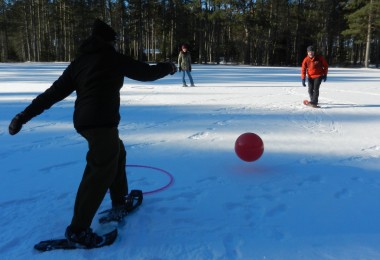“Your genes may load the gun, but your lifestyle pulls the trigger.”
~Julieanna Hever, MS, RD, CPT
_______________
What you put in your body via your gastrointestinal tract [GI] is your inside link to the outside world. It will help or hinder your desired snowshoeing outcomes.
Your GI tract filters what enters your bloodstream and what is discarded.
Your immune system is profoundly impacted by your gut health.
Your immune system will help determine whether your snowshoeing experience is one of effort or struggle.
Plant-based, whole foods provide an array of nutrients you need to excel.
Synergy is the effect of two or more units working together to produce a result not obtainable by each unit independently.
Know that each bite determines your well-being.
A nutrient-deficient diet laced with anti-nutrients destroys your body beginning with your mouth and blindsides your snowshoeing before you leave the house.
It is often a slow, unnoticeable and debilitating process on the outside but is proficient on the inside always seeking a higher gear when you make less than optimal food choices.
Virtually every traditional meal in our society combines a protein with a starch. Eight of ten people have digestive issues. Digestive issues create lucrative opportunities for pharmaceutical, medical, supplement and food industries – and it keeps physicians in business.
It is no secret the prevalence of GI disorders is attributed in most cases to what one chooses to eat.
Physicians mainly treat symptoms by prescribing medications. Medical school focuses on correcting nutritional deficiencies versus nutrition fundamentals. This frontline method of defense is isolated, microscopic and reductionist health care.
A [w]holistic approach to wellness is as vital as consuming whole foods versus isolated nutrients. Wellness is about possibilities not pathology. It is about balance, harmony and synergy not a rigid, short-term medication policy to suppress symptoms.
Optimum wellness and sports performance require awareness and discipline. It also mandates accountability.
Change how you look and feel, regain your health, rid your dependence on medications and addictive foods, and dramatically enhance your snowshoeing and trail running experiences simply by making appropriate food choices.
 Decades of research pinpointed genetics as the primary source for which diseases you are likely to contract during your lifetime.
Decades of research pinpointed genetics as the primary source for which diseases you are likely to contract during your lifetime.
It is now understood that your body has only one disease process but multiple expressions of that disease – depending on your genetic background.
The reality is your lifestyle – especially nutrition and exercise – establishes whether or not those genes are expressed or remain dormant.
The connection among diet, exercise and disease has been clearly established despite your genetic predisposition.
A plant-based, whole foods diet is the most powerful way to prevent and reverse chronic and degenerative diseases. Several studies show this lifestyle to be the most advantageous route to achieving and sustaining optimal health and endurance sports performance.
Find below a crib sheet of what your body needs to help you truly experience synergistic snowshoeing. The daily requirements listed will vary if you are pregnant, lactating or have special needs. Please visit your health care professional or registered dietitian.
Vitamins B12 and D represent the only exceptions in which supplementation may be necessary.
Vitamins
Fat-soluble vitamins require fat for absorption. These vitamins are stored in your tissue and excreted via feces. Excess doses can lead to toxicity. These vitamins are A, D, E and K.
Water-soluble vitamins can be dissolved in water and are eliminated in the urine. These vitamins need to be replenished daily and include the eight B-complex vitamins and vitamin C. It is best to consume raw sources of water-soluble vitamins because heat denatures its enzymatic and nutrient structure.
~Vitamin A
Vitamin A represents a group of compounds vital to growth, vision, reproduction and immune function. Preformed vitamin A is found only in animal foods. Provitamin carotenoids [antioxidants] which can be converted to vitamin A are abundant in fruits and vegetables.
Vitamin A supports growth and repair of muscles and maintains red and white blood cells – crucial for snowshoeing performance. Vitamin A helps resist infection after exertion which facilitates regeneration.
Recommended Daily Allowance [RDA] is 900 micrograms for men and 700 micrograms for women. Plant sources include orange and dark green vegetables, carrots, pumpkin, tomatoes, squash, sweet potatoes, spinach, broccoli, kale, mangos, papaya and cantaloupe.
~Vitamin B1 [Thiamin]
Vitamin B1 helps convert carbohydrate into energy. It is responsible for maintaining high energy levels characteristic of snowshoers. Its presence is in a variety of foods.
RDA for thiamin is 1.2 and 1.1 milligrams for men and women, respectively.
Plant sources include quinoa, oats, barley, beans, peas, legumes, nutritional yeast, tahini, blackstrap molasses, nuts, brown rice and brewer’s yeast.
~Vitamin B2 [Riboflavin]
Vitamin B2 plays a key role as a coenzyme in energy metabolism and red blood cell production. Red blood cells transport oxygen to your muscles. Riboflavin breaks down amino acids to facilitate recovery after snowshoeing.
RDA is 1.3 milligrams for men and 1.1 milligrams for women. Plant sources include barley, beet greens, blackstrap molasses, nutritional yeast, nuts, spinach, sea vegetables, brown rice, legumes and fortified plant milks and cereals.
~Vitamin B3 [Niacin]
Niacin metabolizes glucose and fatty acids, carbohydrate and protein in its conversion of food to energy. It is vital in the production of DNA. Vitamin B3 keeps your digestive system well in order to extract trace minerals to boost your snowshoeing performance.
RDA is 16 milligrams for men and 14 milligrams for women. Plant sources include barley, nutritional yeast, beets, mushrooms, tempeh, peas, potatoes, avocados, sunflower seeds and tahini.
~Vitamin B5 [Pantothenic Acid]
Vitamin B5 helps convert food to energy. it facilitates the production of steroids – a vital part of regeneration after snowshoeing Pantothenic Acid aids the release of energy from carbohydrate, manufacturers glucose and synthesizes fatty acids.
RDA is 5 milligrams for adults. Plant sources include cantaloupe, guava, mangos, oranges, papaya, broccoli, bell peppers, kohlrabi, avocados, seeds, amaranth, buckwheat and quinoa.
Vitamin B6 is integral to your nervous and immune systems properly functioning.
t protects against heart disease and contributes to the snowshoer’s cardiovascular health by circulating greater blood volume – thanks to red blood cell proliferation.
RDA is 1.3 milligrams for men and women ages 19 to 50; 1.7 milligrams for men and 1.5 milligrams for women older than 50.
Plant sources include bananas, figs, raisins, chickpeas, lentils, sweet potatoes, tomato juice, avocados, oats, walnuts and fortified plant milks and cereals.
~Vitamin B7 [Biotin]
Biotin acts a coenzyme during the synthesis of glucose and fatty acids in addition to the metabolism of amino acids and other lipids.
RDA is 30 micrograms for adults – limited data. Plant sources include oat bran, oatmeal, almonds, peanut butter, lentils, black-eyed peas, mushrooms, nutritional yeast and spinach.
~Folate
Folate is a member of the vitamin B family that helps produce and maintain new cells. It teams with vitamin B12 to produce oxygen-carrying red blood cells and promotes muscle repair. Folate also aids the snowshoer by helping your heart maintain smooth, rhythmic beats during exertion.
RDA is 400 milligrams for both men and women. Plant sources include asparagus, collard greens, beets, green leafy vegetables, spinach, pinto beans, black beans, kidney beans, orange juice, amaranth, buckwheat and quinoa.
~Vitamin B12 [Cobalamin]
Vitamin B12 assists with red blood cell formation, neurological function, DNA creation and the conversion of food to usable energy. Plants and animals cannot synthesize vitamin B12. Vitamin B12 is found in the bacteria, microorganisms and fungi consumed by the animal before it is eaten by a human.
Animals absorb vitamin B12 produced by the bacteria in their intestines. Carnivores get their daily supply through animal foods. Vitamin B12 is unique because in order for it to be absorbed it requires ‘intrinsic factor’ to be produced by the stomach.
Cobalamin is the only nutrient a herbivore cannot attain from food or sunlight. Vitamin B12 deficiency in herbivores is rare but serious. Unless you regularly consume the below plant sources deficiency is probable. Vitamin B12 supplements are available.
Supplementation at 5-10 micrograms per day is recommended if one does not consume any of the listed plant sources.
Herbivores can request a MMA [methylmalonic acid] or homocysteine test to determine a blood cobalamin deficiency.
Make certain to purchase methylcobalamin versus cyanocobalamin. The former is better absorbed, retained longer by your tissue, and does not leave a pesky, poisonous cyanide molecule after being metabolized – you read that correctly. The latter [of course] is more prevalent on store shelves.
RDA is 2.4 micrograms for men and women. Plant sources include fortified plant milks and cereals, nutritional yeast, miso and sea vegetables.







Leave a Comment